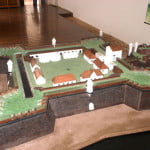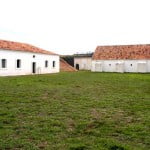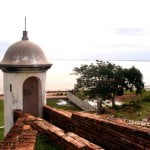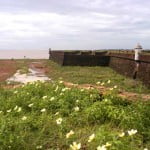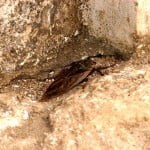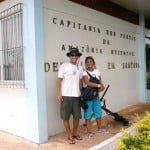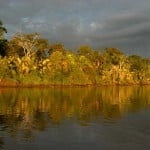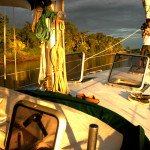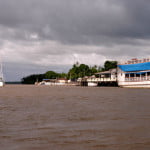04-02-2005
We arrived from São Paulo in the middle of Carnaval’s Friday at midnight. From the airport we drove straight to Santana, at the Capitania dos Portos, where Endless Sea and Alonso awaited us.
The marine warehouse where we were anchored – a small wooden pontoon on the Amazon bed – enabled us to get straight onto the harbor master’s office patio. In fact, the marine’s support came in handy since I wouldn’t have known what to do without it. More and more, the Brazilian shore has become an unsafe area due to frequent robbery. In this region in particular local boats have often been assaulted with violent attacks. It was at this very spot, a few years ago, that the famous Peter Blake was assassinated. I myself was a victim of armed assailants once in Bertioga, on the São Paulo coast, when three people broke into our sailboat one night, one of them holding a 38, another a 44, and the third one a 12. They took everything they could, from the vhf radios to the lifeboats. It was tremendously difficult for Alonso and I, who were onboard. This time, in order to avoid future trouble, I’ve asked for support so that while in Macapá and Belém, “Marzão” will be safely anchored at the Brazilian marine.
We plan to go as far as Belém during this stage of the trip by traveling between the Marajó island and the continent. The mouth of the Amazon is approximately 300km long. You may sail through seawaters, through inner or outer routes, between the island and the continent, up and down several rivers and “holes”, which is what locals call the narrow canals that join the Amazon and the Para rivers. We’ve chosen to take the “inner” route to be able to travel along the river bank and spot each detail of the shore more clearly. Besides being able to get off the boat to visit the villages on the way, it´ll be a more interesting route. Tomorrow we will be first stop in Afuá, a village off the northeast Marajó shore about 45 mi. from the Santana port.
That’s it for today. It’s getting very late.
05-02-2005
We woke up early and headed to the supermarket, then to
the São José de Macapá fort, a beautiful, impeccably maintained 1764 construction. At 10:30 we were already saying goodbye to Brazil’s very last northern state. We had a long way to go, first a few miles down the great river toward its mouth, and then straight starboard, shortcutting through streaks all the way to Afuá.
After having navigated in deeper waters for over three hours, we were faced with an inevitable turnout: the farther ahead we sailed, the shallower the river. Half a mile ahead, we started getting ready to set afloat. I realized I had taken the wrong route, so I turned around. The right way to Afuá turns out to be a tiny river arm amongst the islands right across from Macapá. I had wondered why so many boats were going in that direction, anyway, we decided to follow the locals. Soon we were back on track after quite a waste of time. I wanted to get to town that same evening, but wouldn’t be able to. We might as well pick a nice spot at dusk time, cast anchor and wait till the following day. This time I don´t want any dramatic bogging downs like the Calçoene one.
06-02-2005
We sailed till nearly 2am., at which point we cast anchor and went to sleep. We were very close to the exit of the canal between the Cará islands and the Queimada, or Serraria island. The day before, we witnessed a beautiful sunset .The strong and warm sunlight dressed the forest with yellowish golden shades, as if an aura had mysteriously surrounded the river’s bank in a spectacular view. It enhanced the beautiful colors of the cilia jungle, whose huge trees and great crowns alternated with the typically Amazonian “açaí” trees. What a treat from nature – or rather, a treat by nature!
As we exited the canal separating the two islands, we sailed another five miles across the Vieira Grande Bay towards the Afuá river, on whose bank the friendly town we were about to visit had been laid.
Afuá is a village built on top of palafittes. The soil here is constantly invaded by the river’s floods, in such a way that the entire town is suspended in this fashion. Thirty thousand people dwell in the village and its surroundings.
Upon our arrival around 11 am, we were welcomed by a heavy, yet brief, typically northern shower, the kind who´s sudden friendly downpours leave a nice, cool breeze behind them.
Afuá has character. It’s a unique and gracious village, especially when seen from the boat. Its equally sized houses, most of which are made with colorfully painted wooden planks, reveal a pattern where neatness and intense green stand out as the town’s strong characteristic. Right in its center there is a square and a busy-looking mooring line, given the number of anchored steamers (typical local barge). The dock , surrounded by tracks packed with all types of speeding bikes, takes up a major part of the town. In the background, separated by a river arm, a big sawmill with logs all around it confirmed my previous knowledge: little farming or cattle raising tradition is found in this region, due to the constraints caused by the flooded soil, but lumbering sure is a constant practice.
As we approached the town, we asked a few partying wanderers where we could find a filling station. Once again, we were directed to a river arm nearby where we got diesel and gas. Then, we went back to the front part of the town where we anchored.
We were soon the daily attraction. Dozens of boys came swimming towards us, curiously looking at everything we had, especially at the sailboat, a rare sight for those who lived there.
As we got into town for the usual filming sessions we found there were no streets, but suspended wood passageways, just like the palafitte houses. It’s a kind of Venice in the middle of the jungle, should such an unusual comparison be made. Notwithstanding, the town has its merits. It’s sparklingly clean – as we strolled along the passageways, we even came across containers that had been especially set up for recycling garbage. Since cars cannot ride on the passageways, bicycles are the most common means of transport, so skillful bikers are majority. They cram their bikes on the narrow passageways, many times with the help of a side-cart coupled to their bikes that can fit up to three people. Also, those strange-looking things on wheels display a type of improvised battery-operated sound equipment which, connected to a car battery, usually blasts its music all over town. How interesting.
We tried to interview the sawmill manager, but he refused to talk to us, claiming that he was not allowed to, and that their lumber was 100% “clean” – stamped and all – though I wouldn’t count on it…..
After finishing our sightseeing and recording sessions, we hit the bunks. The following day, we were to head off to Breves, perhaps the biggest town on Ilha do Marajó, situated on the west side of the island right by a narrow canal called Macacos’ hole.
I had hardly crashed on my bunk when the boat began to jolt heavily. I dashed out of bed, realizing “Marzão” was surrounded by huge log clusters being pulled by a small motor-boat, a common practice around here. Only the boatman had made a very sharp curve, forgetting that the logs might hit my boat’s hull, which they did! I screamed, honked the horn and flashed our lantern until the boatman realized he had to stop the engines. Instantly, another boatman jumped onto the log clusters, which were 60-70 meter long, and “ran” towards us in order to help push “Endless Sea” away from the menacing logs.
The whole scene was quite exotic, but fortunately everything turned out to be ok. Feeling still pretty confused, I went back to bed and slept soundly till 6a.m.
07-02-2005
I was awaked by the boat’s engine being started. As I jumped out of my bunk , I was able to catch a glimpse of Afuá from the poop. A reddish sky unwrapped the town to a beautiful sunrise scenery. It was an unforgettable moment of rare beauty. Today we are going to sail around 100 miles all the way to Breves, the biggest town on the island where 80.000 people live.
We reached the Vieira Grande canal soon after we left Afuá, and from there we headed towards the Macacos “hole”.
Traveling on these large rivers or canals can be quite tedious. It is difficult to enjoy the scenery when you are 3-4 miles off the shore, or even farther. I decided to go down to the cabin and write my reports. I was barely starting when I heard Paulina puffing and blowing from outside. Soon she dashed inside, cursing and wagging her head back and forth while she complained to Alonso:” Are they going to get in here, I wonder?” With all that melee, I had to stop and see what was going on. As my eyes met Paulina’s, she spilled out: ”João, go outside and check out the swarm of bees that has taken over your boat”, she said, giving special emphasis to “your boat”.
I did. Not that I believed the news 100%, but I did go.
Over the cockpit -which I call “my terrace” – there was indeed a hum of tiny insects buzzing to and fro. Steering the helm, Alonso would buffet the air with a rolled-up shirt, aiming to the left and right just like one would do with a paddle. Even so, I wasn’t exactly worried. It was then that I saw the mast from underneath the awning. I stuck my head out and saw a thick, black moving cloud turning into a beehive up the major mast’s crosspiece. I couldn’t believe my eyes. Thousands of bees were tightly flocked together, piling themselves up to busily build something right there. Others had been swallowed by the bow sail as it was drawn out to get way from the flying intruders. It can be quite amazing to sail on a hydrographic basin – you’re always caught by surprise! Honestly, I didn’t expect to come across thousands of bees….Fortunately, they were “friendly bees”, the ones with the black and yellow butts, whatever they are called, all I know is that thank god they were not the frightening African bees.
I decided to do nothing. There was nothing to do, anyway. To this day, I never carry any extermination equipment onboard, but I wonder if I should. I went down back to my reports, and just as they had come, the bees abruptly vanished down the canal.
So much the better. We’d had enough with the sea roaches that sneaked onto the boat when we were at the Macapá port. I’ll say this much: I’d rather deal with bees. Those roaches are not from this planet! They’re horrendous and abnormally big. Some get to be the size of your palm, and just as long and wide – they’re the scariest things! Even boric acid, an efficient cockroach killer I always have on board, can’t exterminate them. Unless you hit them strongly with an axe or a club, or why not a good old 38!
Take a peek at the photos I’ve made of a paunchy one touring inside the basement at the São José Fort. It’s guaranteed fun.
Well, after traveling plenty of miles along the great Vieira canal, we entered the beautiful Macacos “hole”. It’s a narrow route boarded by gorgeous woods sprouted by poverty-stricken, but neatly presentable palafitte houses. Whenever we approach one of those homes, children pick up their canoes and row towards us. We have to quickly steer away from them, otherwise we run a risk of unintentionally sinking them. This is the local kids’ favorite sport. They remind me of dogs roaring after car wheels in countryside towns, and they think it’s cool to get dangerously close to the vessels, surfing our breakers and asking for little presents. I knew about this tradition here, so I brought a bunch of old t-shirts and lots of crayon boxes. I’d wrap one of each into packages made with plastic grocery bags, and whenever their boats came closer, we’d throw them what Paulina called “ bombs of hope”. It was quite a party.
The population around here is very poor and withdrawn from civilization. They live on palafittes in the middle of the woods on the channels´ banks. Only through their boats can they communicate with the outside world – they wouldn’t survive without them. The Amazon basin’s 100% navigable routes are 20.000 km long. It’s something magnificent which fosters a tradition of a many different types of vessels. They go from the kayak-like dug-out canoes that ride up to 3 people to the large steamers that transport hundreds of passengers swinging on their hammocks, or the cargo barges (“batelões”) and trader boats (“regatões”) carrying goods which they trade with the locals along the way. Everyone depends on the boats , since the river provides transportation, food, fishes and other items essential to survival. Apart from that, copper-colored natives (“caboclos”) make a living extracting wild palm and selling it to small factories on the way, besides using it for their own consumption. Some of them grow root edibles or have small vegetable plantations, though they get by mostly on wild fruits such as “açaí’, mangos, mauritias (“miritis”) and iambs(“jambos”), all of them picked in the forest.
It’s a pity there are no sustainable political measures to stop this great social segregation. With less baloney or demagogy, such as “people starve in Brazil”, governments ought to make better use of their “IBGE” (Brazilian Institute of Geography and Statistics) data, among others, and enforce serious, lasting policies to bring these groups into society’s mainstream, enabling them to be economically active in their own way. As it is, they have been utterly abandoned, deprived of whatever sustainable means to ensure that they move ahead at all. The most they can do is get into the forest and fell trees, helping crooks fill up their pockets with illegal hardwood trading. Or worse than that. They may end up in the hands of exotic animals smugglers, catching rare birds and fishes which will decorate some pet shop in the United States, Germany or Japan, in most cases.
The data below show the dramatic scope of such crimes:
Thirty eight million animals are illegally taken away from nature every year, usually smuggled from poor tropical countries into the rich first world nations. Only one out of four animals manages to survive.
“Illegal trading puts great pressure on the species being smuggled, making their population scarcer and affecting their survival. Besides, the Brazilian socio-economic scenario makes it easier for illegal trading practices. Providing the local population with economic opportunities and training on environmental issues, besides incrementing supervision policies, may be efficient measures to reduce the illegal trading of wild animals.” The quote above was published in the IBGE’s “Figures on Sustainable Development – Brazil 2004”. Instead of fomenting the creation and implementation of public policies, which is what ought to be done, the data published by the Brazilian Institute of Geography and Statistics have recently become a reason for President Lula’s aggravation, simply because he’s convinced that “the Brazilian people starve”. His favorite statement in his campaign, this line elected him president. However, he resents the fact that the institute says things may not be quite like that. Instead of taking advantage of the valuable data which the IBGE brings to light every year and promote inclusive policies, the men from Brasilia would rather edit the Brazilian IBGE “photography” by vetoing their data. Isn’t that amazing? Can data be edited only because it´s not what one expects it to be? It’s as simple as that. As for anyone who disapproves of what’s being done, too bad! Where in the world is my MST cap?
Be it the lack of initiative, be it the waste of time with baloney, be it the embezzlement crimes with income tax money committed via so many state agencies that drain public investments away from tax payers, using 20% to 30% to cover up tips on the side, commissions, unrealistic payroll, inefficiency and corrupted public administration. If it weren’t for all this nonsense, there sure would be plenty of resources to be used in environmental education for people in this region as well as in other areas in Brazil. As a result, they would be “with us” rather than “against us”, as is the case when they work for a few crooks such as lumber dealers or wild animals smugglers.
The local population could very well inspect and take care of this great diversity by denouncing potential threats to the environment, instead of being forced to make peanuts working for illegal organizations controlled by big bosses.
However, we can’t expect so much from a given government or ministry. They might as well keep on wasting time and money, trying to stop technology from reaching the rural areas and increasing productivity, which is what the “green” PT members are doing while they campaign against genetically modified products, or when they discontinue highly respectable departments such as Embrapa totally by surprise.
In the meantime, the other folks, those who smuggle wild animals out of the country, have a 10 billion dollar turn over throughout the world yearly. And worse than that, Brazil stands for 10% of this market in the world; in other words, for the appalling total of one billion dollars!
But hold on because I’ve got lots to do. I am very busy today. Let me call Zé, my “assistant”, “For God’s sake, Zé, give me a hand, will you? Which cap or t-shirt should I wear tomorrow, huh?”
08-02-05
We didn’t manage to get to Breves yesterday. We had to anchor and spend the night in the middle of the canal. It was getting late and we didn’t have enough daylight to keep on sailing.
We arrived at noon today, and as usual, before getting into town, we passed by some boat convoys pulling endless log clusters through the water. There goes our diversity being exported abroad….We also went by a gigantic sawmill which spitted smoke out of its chimneys uninterruptedly. Out of it came an unbearable smell of wet wood. It had the sour, fetid quality of overnight vomit.
As we went past the sawmill we got to a big dock where dozens of boats lined up. Small, average-size and large steamers jammed with hammocks awaited their passengers. It was carnival, but the streets were nearly empty. Even so, we could see a few masked carnival dancers strolling down the streets. A bit further into the downtown area, on a wide avenue, lay a run-down, unattractive wooden passageway which resembled those used in the samba grandstands, which have become fashionable and spread throughout the country like a plague. In the middle of the avenue, a pick-up truck had loud, powerful speakers blasting distorted sounds of cheap music that was as unbearable as the smell coming out of the sawmills. It was some new beat whose English name I ignore, the kind of music that has nothing to do with carnival. This was the poorness of spirit that rocked some discouraged carnival dancers who insisted on marching next to the van, sometimes making a “V” sign with both hands, arms up, in a typical carnival gesture.
Holy Christ!
We did some sight-seeing while recording everything on videotape, then made some takes for the TV show and rushed back to the boat. I was appalled by the litter on the streets. It was just stunning. What is most discouraging about this is our politicians’ lack of drive, for they could keep this town clean if they wanted to. All they need is some real political interest. Afuá, another town near here also located on the Marajó island has just as many social problems, but they have recycled garbage bins everywhere you go. So if one town can make it, why can’t another? I witnessed the same discrepancy in Amapá. On one side of the river was Oiapoque, the filthiest and most chaotic place ever, whereas right across from it, on the opposite side was the French village called Saint Georges, the neatness, most spotless civilized place. It’s a real pity.
Back onboard of the Endless Sea, I fixed myself a shot of whiskey, started playing my Brahms Quartet – for clarinet , and indulged myself into the kitchen, one of my favorite hobbies on the boat. For dinner we’ll be having ground beef pastries, rice and tomato salad.
09-02-05
One again we woke up to record. We sailed along a canal right in front of Breves, the prettiest spot so far. Its beautiful shores are crammed with “açaí” trees surrounded by a beautiful forest, several houses, schools, churches, and of course, the usual sawmills. We took plenty of shots, passed by some large steam barges and headed towards “Curralinho”, an off the “holes” town on the shore of the Pará river, right before the mouth of the Tocantins river.
Navigating around here can be dangerous. Sometimes we are chosen by some swarms of bees that make a point of building their hives on top of our mast. Other times we are nearly run over by the dugout canoes when the locals come closer to “play”, not to mention the fact we have to watch out for the logs that float dangerously close to the boats. However, you needn’t pay much attention to notice the greatest problems in Pará: lumber dealers, systematic grabbing of public land, devastation, violence, all of them moving further and further into the forest. We can’t help seeing sawmills all throughout this stage of our journey. There are dozens of them. There is a sawmill installation every 5.6 miles on this shore. Similarly, at a similar or even quicker pace, we can see boats pulling log clusters up and down the rivers. It’s appalling to witness the state’s overt and scandalous omission of all this – one more reason to believe that the Brazilian environmental policies are deeply flawed and completely aloof.
Almost 40% of our GDP is payed by taxes, and even so we can’t afford to have enough policemen to keep our big cities safe, let alone our environment.
Where will all our money end up if the state continues to fail to account for its major responsibilities?
15% of the Amazon forest has already been destroyed, and the deforestation process keeps growing implacably. 25.000 square meters are lost every year. All our governments do is create reserves and national parks on paper. Without efficient supervision policies these reserves only help demoralize our legislation even more, since they continue to be depredated exactly the same way. It’s dramatic!
It was extremely hot as we reached Curralinho at dusk. We tried to set anchor in front of the town, but couldn’t. The river bed has an unusual formation, a type of hard yellowish mud which can be as sticky as kids’ clay. We threw the anchor several times, but it would slip over the water, refusing to ground into the mud. We had no choice but to stop at the dock, in front of the town’s main street. We got off to start filming and to get some interviews, this time with the town’s Secretary of tourism and culture at the City Hall. Curralinho is much smaller than Breves, whose population totals 80.000 people. Here the population totals around 15.000 people. It’s a pretty well-taken-care-of town, though there is nothing special about it. I chose to spend the night here safely instead of traveling on the Pará river where there are all types of boats cruising the night. Even so, we had a few difficulties. A large steam barge approached the dock, and although we had been staying at one of the dock’s endings, it couldn’t avoid grappling our shoulder as it tried to stop. After a few minutes of holding and pushing which made everyone pretty uptight, the two boats split away from each other. The steamer picked up a few passengers and went on its way. We were finally able to go to sleep.
10-02-05
Today is our last day on this leg. We’ll be traveling straight through, from Curralinho to Belém. We’ll cruise 90 miles on the Pará river, which, despite being very wide and muddy, has been given good traffic signs by the chart. There are plenty of lighthouses on the way since marine traffic is heavy around here. We passed huge barges shipping goods from Pará to Amazonas and vice-versa, some of which were sail boats while many were fishing boats. It was a nearly 10-hour journey, but without incidents. Towards the end of the day, at the Barcarena port vicinities, we were welcomed by a marine motor boat that had been waiting for us. It escorted us all the way to the Belém port, where we arrived by night. At this moment the Endless Sea is anchored at the Capitania dos Portos, with the help of the Brazilian marines, waiting for the next stage of our journey.




